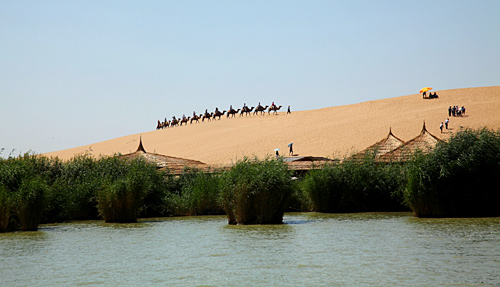|
 |
|
WATER IN THE DESERT: The Sand Lake, a major tourist resort in Ningxia, receives around 500,000 visitors each year (WANG LEI) |
Crystal rivers, blue skies and flowering woods surround this city—you probably won't believe it is Yinchuan, the capital city of the Ningxia Hui Autonomous Region in less developed northwest China. Shrugging off its former image of being a badly polluted region due to the coal mining industry, a lifeline for millions of local people for decades, the region is stunning tourists from around the globe with its natural and cultural wonders.
Wandering through the broad streets of Yinchuan, an air of vitality and Islamic exoticism is clearly present. Shining skyscrapers and towering apartment complexes are proof of the benefits that have trickled down to the region, after years of rapid development.
What has added luster to the economic landscape is an influx of tourists. The region received a total of 9.1 million visitors from home and abroad in 2009 and raked in 5.34 billion yuan ($787.6 million) in revenues, up a whopping 32.5 percent from one year ago, said Xue Gang, Director of Ningxia Tourism Administration.
The charm of Ningxia arises from its snow-capped mountains, a vast expanse of desert, Islamic mosques and many cultural relics. The region has a rich history, and the evidence of that is everywhere. Most prominent are the ancient rock carvings in the Helan Mountain in the northern area of the region. Mostly reflecting the nomadic lifestyle of ancient people like hunting and sacrifice, the carvings provide a glimpse into human civilization thousands of years ago, which has a strong appeal for visitors.
To curious travelers, the Western Xia Imperial Mausoleum is another historic wonder. Just 20 km west of Yinchuan, the pyramid-shaped tombs were built for emperors of the Western Xia Kingdom (1038-1227) that ruled the region around 1,000 years ago. Each major tomb was flanked by four corner towers, watchtowers, a sacrificial hall, a coffin platform and stone tablets. Though most parts of the ruins have eroded beyond recognition, the tombs offer some clues about the mysterious kingdom. Most importantly, a good number of relics, including porcelain, gilt silverware, bamboo carvings and clay sculptures, were found there.
After a day's hiking in the mountains or exploring Yinchuan's bustling downtown area, there is no better place to cool off than at a sand lake resort in Pingluo County of Ningxia.
|
